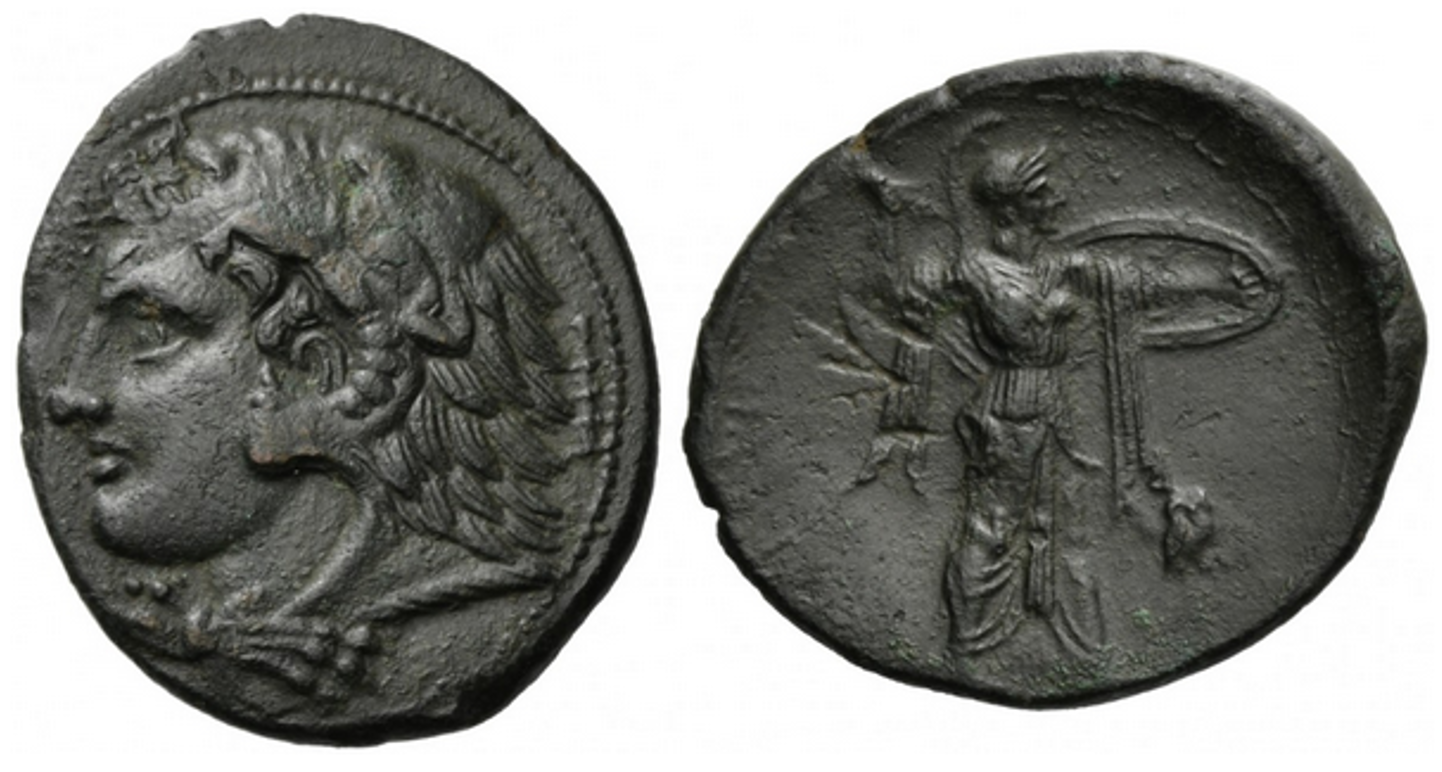2720 - Syracuse (AE Heracles/Athena) over Syracuse (Artemis/thunderbolt) (Bertolami, 52, Nov. 2018, 58): Difference between revisions
From SILVER
No edit summary |
|
(No difference)
| |
Revision as of 18:13, 26 July 2023
278 BCE - 276 BCE
Images
Overstriking coin

SO_1687_-_Syracuse_(AE_Heracles-Athena).png [1]
Location/history
| Sale(s)Sale(s) ᵖ: | Bertolami Fine Arts, 52, 8 Nov. 2018, 58 | |
Overstriking coin
Description
| ObverseInscription or printing placed on the obverse.: | Head of Herakles left, wearing lion skin headdress. In right field, club. Border of dots. | ReverseInscription or printing placed on the reverse.: | Athena standing right, wearing chiton and helmet, holding spear with right hand and shield attached on left arm. |
Mint and issuing power
| MintIdentifies the place of manufacture or issue of a numismatic object.: | Syracuse | Ancient regionAncient region. | Magna Graecia (Sicily) | Modern countryModern country: Italy | AuthorityIdentifies the issuing power. The authority can be "pretended" when the name or the portrait of X is on the coin but he/she was not the issuing power. It can also be "uncertain" when there is no mention of X on the coin but he/she was the issuing power according to the historical sources: | Pyrrhus (general, Aeacid king of Molossians, Macedonia and Epirus, 306-272 BC) |
Chronology
| FromIdentifies the initial date in a range assigned in a numismatic context. 278 BCE toIdentifies the final date in a range assigned in a numismatic context.. 276 BCE | Hellenistic 323-30 BC |
Physical description
| MetalThe physical material (usually metal) from which an object is made.: Bronze |
WeightWeight of the numismatic object (in grams). in grams: 6.366.36 g <br />6,360 mg <br /> | DenominationTerm indicating the value of a numismatic object. Examples: tetradrachm, chalkous, denarius.: denomination A/B | AxisDescribes the directional relationship between the obverse and reverse of a numismatic object.: 44 mm <br />0.4 cm <br /> |
| DiameterDescribes diameter of an object (in mm).: 2525 mm <br />2.5 cm <br /> | |||
References
| Coin referenceReference of the Coin: | Coin series referenceReference to coin series study: | Calciati 19861Calciati 1986, p. 292, n° 175, 177, HGC 22HGC 2, n° 1450, Puglisi 20093Puglisi 2009, p. 328, n° 330 | |
| Coin series web referenceCoin series web references: | |||
Overstruck type
Description
| ObverseInscription or printing placed on the obverse.: | ReverseInscription or printing placed on the reverse.: |
Mint and issuing power
| MintIdentifies the place of manufacture or issue of a numismatic object. ᵖ: | Ancient regionAncient region. ᵖ | Modern countryModern country: | AuthorityIdentifies the authority in whose name (explicitly or implicitly) a numismatic object was issued. ᵖ: |
Chronology
| FromIdentifies the initial date in a range assigned in a numismatic context. toIdentifies the final date in a range assigned in a numismatic context.. | periodTime period of the numismatic object. |
Physical description
References
| Coin type referenceReference to coin series study ᵖ: |
Additional data
| Frequency of overstrikesFrequency of overstrikes: | Level of confidenceLevel of confidence of the identification: | ||
| RemarksRemarks: | |||
References
- ^ Calciati, Romolo (1986), Corpus nummorum siculorum. La monetazione di bronzo/The bronze coinage, vol. 2, Milan, Edizioni G. M.
- ^ Hoover, Oliver D. (2012), The Handbook of Greek Coinage Series. 2. Handbook of the Coins of Sicily (Including Lipara). Civic, Royal, Siculo-Punic, and Romano-Sicilian Issues. Sixth to First Centuries BC, Lancaster-London, 489 p.
- ^ Puglisi, Mariangela (2009), La Sicilia da Dionisio I a Sesto Pompeo : circolazione e funzione della moneta, Messina, DiScAM, p. 519.